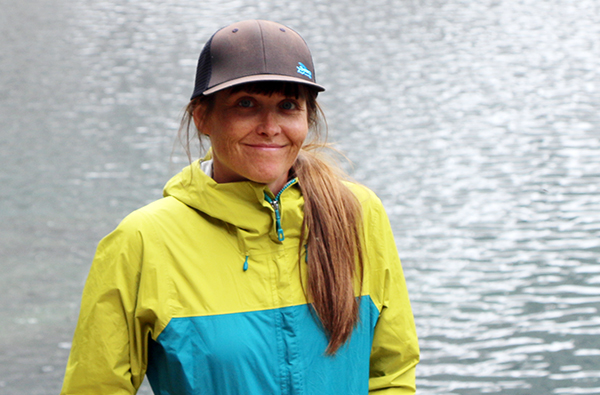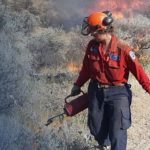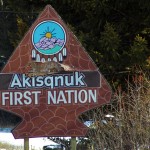Home »

Golden-based biologist devoted to the Columbia Wetlands
Faces & Places: Rachel Darvill
By Nicole Trigg
Kootenay Conservation Program

Passion for biodiversity and commitment to conservation define the sheer scope of Rachel Darvill’s work experience as a wildlife field researcher, environmental consultant and biologist over the past two decades.
Her career has spanned different parts of B.C. (including Haida Gwaii, the Central Coast as well as the Interior), different countries (Alaska/Washington, USA; Tanzania, Africa; Bocas del Toro, Panama; the Virgin Islands), different species (elephants, whales, birds of prey, sea turtles, bears and seabirds to name a few), different occupations (overseas volunteer research assistant, sea kayak guide and bear guide), different organizations and institutions (Environment and Climate Change Canada’s Canadian Wildlife Service, Simon Fraser University, Parks Canada) and none of these examples are an exhaustive list.
Originally from White Rock, Rachel relocated to Golden at the age of 23 to pursue her love of snowboarding with a Bachelor of Science in Biology and a Minor in Environmental Studies from the University of Victoria under her belt.
For the next six winters she worked at a ski resort spending summers away either travelling internationally or working different biology contracts that brought her all over the north and Pacific Northwest, and into Banff. After shifting gears and settling in Golden full-time with her partner and their son, Rachel completed a Master of Science in Environment and Management remotely from Royal Roads University (earning an overall GPA of 4.2 and the Chancellor’s Award for highest academic achievement in the process).
In recent years, she’s developed and been the program biologist for three bird conservation projects: the four-year Columbia Wetlands Marsh Bird Monitoring Project, the five-year Columbia Wetlands Waterbird Survey, and currently the new multi-year Columbia Valley Swallow Project administered by Wildsight Golden.
On behalf of the Columbia Wetlands Stewardship Partners for the Kootenay Conservation Program’s Kootenay Connect project, Rachel is also coordinating inventories for two species at-risk species found in the Columbia Wetlands: Western painted turtle and Lewis’s woodpecker. She’s conducting osprey inventories; and is working to establish Wildlife Habitat Areas for mountain goat licks and for an at-risk ecological community.
Through her own consulting business, Goldeneye Ecological Services, she is working on a wetlands inventory project funded by the Fish and Wildlife Compensation Program and works on various inventory projects for the Lake Windermere Ambassadors.
“The Columbia Valley Swallow Project is one of the projects I’m most passionate about,” she said.
The Columbia Valley is home to six different species of swallow, but the focus for this particular project is on barn and bank swallows, both of which are listed as threatened under the Canadian Species at Risk Act (SARA).

“The bank swallow is severely threatened, it’s estimated that 98% of bank swallow population has been lost from Canada in the last 40 years, and I believe we have a duty to protect the remaining two per cent,” said Rachel.
Launched earlier this year, the Columbia Valley Swallow Project is collecting data on swallow nesting sites. This inventory work will lead to conservation, restoration and enhancement efforts for barn and bank swallows in subsequent years.
So far, Rachel has coordinated over 60 volunteers to help inventory swallow colonies. She and her volunteer team have found around 100 bank swallow colonies in the Columbia Valley (between Canal Flats and Donald) – a much higher number than the roughly 35 previously thought. Some of the colonies are massive — the largest over 1,000 birds. The active bank swallow colonies on Columbia Lake alone come to approximately 35, and 25 or so have been found along Lake Windermere.
On the other hand, she’s surprised by the low number of barn swallows surveyed to date, with just three relatively significant colonies identified. Volunteers have also been counting the nests of cliff swallows, which nest on bridges and near barn swallow colonies. Northern rough-winged swallows, which nest in burrows in sandy cliff banks, are similar in appearance to the bank swallows.
“Often people think we have just one swallow species, for instance a number of barn swallow sightings reported to me have ended up being tree swallows,” Rachel sad. “Tree swallows seem to be the swallow species that’s in highest abundance in the Columbia Valley.”
Public outreach and education are and will continue to be an important part of the project.
“All migratory birds are protected under the Migratory Birds Convention Act and through that act, all birds, their eggs and nests are protected year-round. They also have an extra layer of protection through SARA if they are a species at risk,” Rachel said. ”I think that swallow nests are often removed from buildings due to valid aesthetic or health concerns, but many people don’t recognize that birds and nests are protected.”
Many of the volunteers with the swallow project worked with Rachel on the five-year Columbia Wetlands Waterbird Survey that she completed through Wildsight Golden last year. That survey data collected has been submitted to Birds Canada, the agency tasked with designating International Bird and Biodiversity Areas (IBA) in Canada. An IBA designation for the Columbia Wetlands would recognize the area as globally significant in terms of the habitat value provided to birds and Rachel said it looks promising.
Learn more about the Columbia Valley Swallow Project.
See a video overview of Rachel’s Kootenay Connect species at risk report.
The Kootenay Conservation Program is a broad partnership of over 80 organizations from across the Kootenays that works to conserve landscapes in order to sustain naturally functioning ecosystems. Learn more at www.kootenayconservation.ca.
Photos submitted







